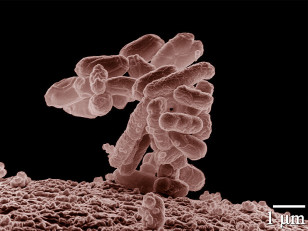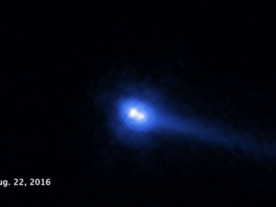NASA Cassini Mission to Saturn Comes to Fiery End
English Poet Geoffrey Chaucer once said, “all good things must come to an end”.
And so it goes with NASA’s Cassini mission, which provided a close-up look of Saturn, its moons and famous rings over the last 13 years, came to a blazing end on September 11, 2017.
The space agency sent the spacecraft plunging through the ringed planet’s thick atmosphere to its total destruction.
Earl Maize, the Cassini program manager, announced the end of the mission.
“Just heard the signal from the spacecraft is gone and within the next 45 seconds, so will be the spacecraft.”
NASA says even as it was being sent on its fiery final journey, the spacecraft continued to collect and transmit valuable data back to Earth.

An electron micrograph of a cluster of E. coli bacteria, magnified 10,000 times. Each individual bacterium is oblong shaped (USDA)
Bacteria Shapeshifts in Space
Scientists, who sent a unique experiment up to the International Space Station, have learned that bacteria can be quite adaptable in order to survive.
A group of scientists, led by researchers at the University of Colorado, Boulder, found bacterial cells, when treated with a common antibiotic, in the near weightlessness of space, resorted to maneuvers such as shapeshifting to avoid being destroyed.
The researchers cultured some E. coli bacteria on the Space Station and then exposed it to an antibiotic that normally kills it on Earth.
They found that rather than being wiped out by the antibiotic, the number of microbes increased by 13 times and behaved in other ways that may have added even more protection from the antibiotics.
The researchers say their findings have implications for those in space and on Earth.

Artist’s concept of the New Horizons spacecraft as it approaches Pluto and its largest moon, Charon. (Johns Hopkins University Applied Physics Laboratory/Southwest Research Institute (JHUAPL/SwRI))
New Horizons Roused from Summer Slumber
After hibernating for the last five months, officials with NASA’s New Horizon’s Mission recent roused the spacecraft from its slumber.
Before being put to sleep in back on April 7th, New Horizons had been awake and at work since December 2014.
During that time the spacecraft prepared for and conducted its historic close encounter with the dwarf planet Pluto and Charon its largest moon.
It then spent another 16 months sending all its observational data back to Earth.
New Horizons will be kept plenty busy until its next scheduled hibernation in December.
The space agency says it make observations of distant Kuiper Belt Objects, measure its environment and prepare for its flyby of Kuiper Belt object 2014 MU69 on New Year’s Day 2019.

Rosetta’s NavCaM snapped this shot of Comet 67P/Churyumov-Gerasimenko on November 20, 2014 ((C) ESA/Rosetta/NAVCAM – CC BY-SA IGO 3.0)
Does Organic Material on Comets Predate our Solar System?
Among the findings made by the European Space Agency’s Rosetta mission, that ended a year ago, is that comet 67P/Churyumov–Gerasimenko contained a good amount of organic compounds, which have been associated with life on Earth.
Scientists theorize that comets delivered material that may have kick-started life on our planet almost 4 billion years ago.
Researchers at the French National Center for Scientific Research say they found evidence in data gathered by Rosetta that suggests these organic compounds may have been produced in interstellar space, well before the solar system was formed over 4.6 billion years ago.
If the organic compounds were indeed produced in interstellar space, the researchers suggest it might be possible that life on other planets in our galaxy may have been seeded in the same way theorized for Earth.

NASA’s Solar Dynamics Observatory captured this image of a solar flare – as seen in the bright flash on the right side – on Sept. 10, 2017. The image shows a combination of wavelengths of extreme ultraviolet light that highlights the extremely hot material in flares, which has then been colorized. (NASA/SDO/Goddard)
Solar Flares Keep Sun Active
The sun has been quite active recently, erupting with more than a half dozen solar flares in recent days.
A solar flare is described as a quick outburst of magnetic energy that occurs on or near the sun’s surface.
Most of the solar flares have been considered to be mid-level in strength, but a couple of significant flares blasted from the sun on September 6 and 10, 2017.
Scientists from the UK’s University of Sheffield and Queen’s University Belfast in Northern Ireland say the September 6th eruption was the largest solar flare that’s been observed in 12 years.
And NASA says its Solar Dynamics Observatory detected what it describes as a significant solar flare on Sept. 10th, 2017.
Scientists say the two huge solar flares were not harmful to humans because of Earth’s protective atmosphere and the distance from the sun.























Comments are closed.